1984 German Grand Prix race report
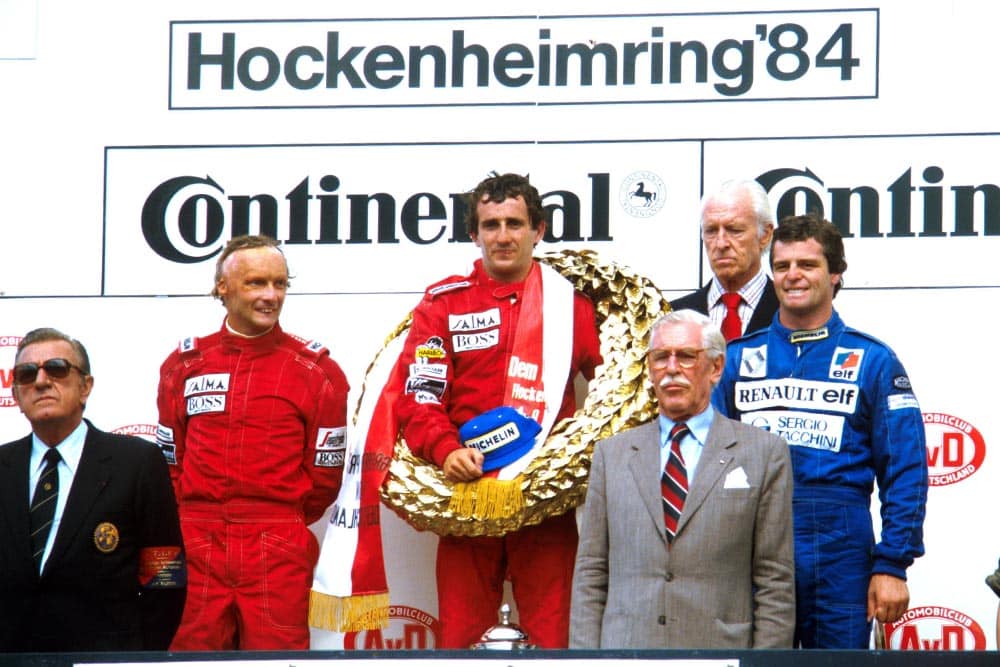
Alain Prost celebrates his win next to Niki Lauda (left) and Derek Warwick
Motorsport Images
Hockenheimring, August 5th
With the opening of the new Motodrome in the Eifel Mountains, to replace the legendary Nurburgring, there was a feeling at the Hockenheimring that 1984 might see the last German Grand Prix to be held there. People who had this feeling had yet to visit the new Eifelring and they were not looking closely at the success of the Formula One races at Hockenheimring over the past few years. Not success by the standards of exciting races or legends being made, but the simple one of 100,000 paying costumers packed into a stadium, making a financial success for the organisers. A stadium to the German populace is a bit liken golf course to the British, it is part of their nature and upbringing, and when that Stadium is alongside an Autobahn and only a few minutes from vast urban areas it is not surprising that the crowds pour in. Whether the same crowds, the stadium-goers, will travel all the way to the Eifel mountains is another question. To go to the mountains for a weekend of camping and open-air activities is one thing, but to sit in a concrete stadium and have to use binoculars to see the cars and drivers is something else.
As proof that you can get used to anything is the fact that few people inside Formula One complain about Hockenheimring any more. The organisation is trouble-free, the whole affair runs smoothly, traffic organisation is very impressive, even though it does mean traversing the small town of Hockenheim, and there is an air of organisation that is efficient if bland and impersonal. The flat and fast circuit (apart from the Mickey Mouse bit inside the stadium) leaves very little impression, for any sort of driving challenge has long since been removed by the introduction of “chicanes”. The Hockenheimring is where the German Grand Prix is held and every year someone wins it, but for the life of me I can’t remember who won it last year, or how he did it! It’s that sort of place.
If you looked upwards out of the concrete stadium on Friday morning you saw the most beautiful blue skies, and the sun was shining brightly. Just right for photography, so the morning test-session got under way with Warwick (Renault) and Fabi (Brabham) setting off with film cameras mounted behind their heads, while others began the serious business of testing tyres, suspension, aerodynamics, boost pressure and all the other variables in preparation for the afternoon qualifying hour. Although everyone was ready the session seemed to get going rather slowly, but gradually the normal pace developed with all the expected fast drivers up at the front of the time list, all the slow ones at bottom, and the mediocre midfield with all the right people in it. Just behind the really fast boys was young Ayrton Senna in a brand new Toleman-Hart using a Ferrari-type rear aerofoil in place of Rory Byrne’s unique double rear aerofoil. This sight of Senna up with the fast boys is something that is becoming a regular occurrence, rather than a flash-in-the-pan, which puts into perspective any detractors of the Hart 4 cylinder engine.
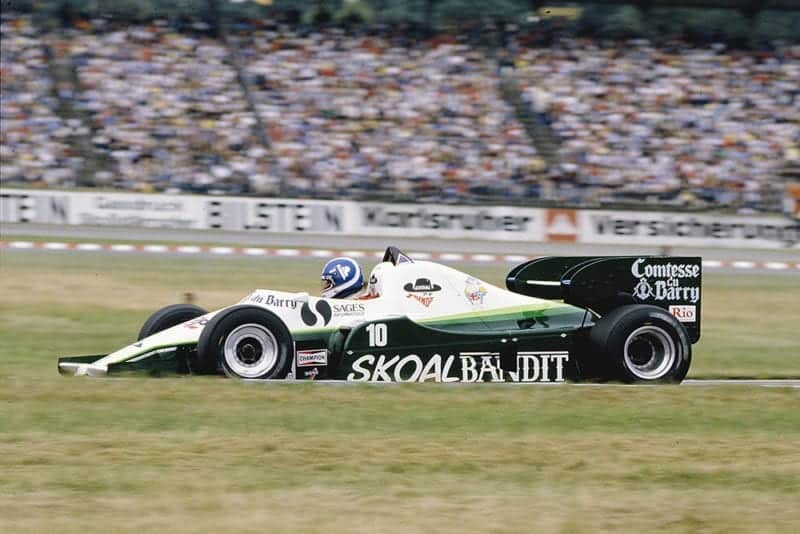
Jonathan Palmer qualified his RAM 25th
Motorsport Images
Team Lotus were in dire trouble, Mansell walking back to the pits after abandoning his Lotus-Renault, and de Angelis using the T-car after his own car blew up. Ferrari had brought along four cars for Arnoux and Alboreto, each driver having a car with new rear suspension and one with the old suspension. As neither driver seemed able to decide whether the new suspension was an improvement over the old system, they both opted to use their T-cars with the old-type suspension. Mauro Forghieri’s look of despair told it all. If engineers cannot get any intelligent feed-back from the drivers how on earth can they make progress? In the McLaren camp, as always, there was quiet progress being made as Lauda and Prost made their plans to win the German Grand Prix. In the Brabham pit it was a similar scene, the BT53 cars using carbon-fibre brake discs and pads on this circuit that gave the brakes a fairly easy time as regards their rate of application and freedom from heat build-up. Piquet was his usual confident and mischievous self, while Teo Fabi was aiming to get down to Formula One seriously, having rid himself of his American racing commitments in the CART series.
At the lower end of the field the MacDonald RAM team had really worked overtime and rebuilt both the cars that were damaged at Brands Hatch, and the Osella team had rebuilt the car that Gartner crashed. Tyrrell had his three 012 cars in the pit lane, but neither of his regular drivers, Brundle still being on the sick-list and Bellof being committed to an Endurance race in Canada with the works Porsche team. Stefan Johansson stood (or to be more precise, sat) in for Brundle in 012/4 and Mike Thackwell took the place of Bellof in the black 012/5. The team is still under the cloud of suspicion, following rule breaking, and until Ken Tyrrell’s appeal is heard by the FIA, the cars are being allowed to take part in the Grand Prix events, but not in the World Championship. Before practice started it was made clear that the 26 cars on grid rule would be changed to 27 if any regular Championship contender qualified behind the Tyrrell cars. If the Tyrrell cars were 26 and 27 in qualifying, the 26 cars rule would apply. The ATS team appeared to be well-organised, with a brand new D7 car to supplement their original one, and the Arrows team had a full complement of three BMW-powered A7 cars.
Qualifying
It was still very warm when qualifying began at 1 pm and Piquet was out almost immediately to set a bogey time of 1 min 48.698 sec, which gave an average speed of 140 mph. He did this in his “race” car (BT53/4) rather than the “sprint special” qualifying car (BT53/3), as the latter had given trouble during the morning testing. This bogey time did not last long, for both Warwick and de Angelis beat it, the Lotus driver almost breaking into the 1 min 47 sec bracket, with an impressive 1 min 48.033 sec lap. Their team-mates were not with them on this occasion, Tambay still sorting out a brand new Renault (RE50/09) and Mansell having gearbox problems. These eventually turned out to be some new Italian-made gears, delivered direct to the circuit, being .020 in oversize on the dog-depth. After they had been corrected in a local machine shop everything worked perfectly, but it was not put right until race morning. Lauda was in fourth place and just behind him was that young man Ayrton Senna and the Toleman-Hart! In 27th place was Rosberg. There was little point in asking what was wrong, for if Frank Williams and Patrick Head knew, Rosberg would have been up in the first half-dozen. It looked like it was going to be “one of those days” for the Williams team.
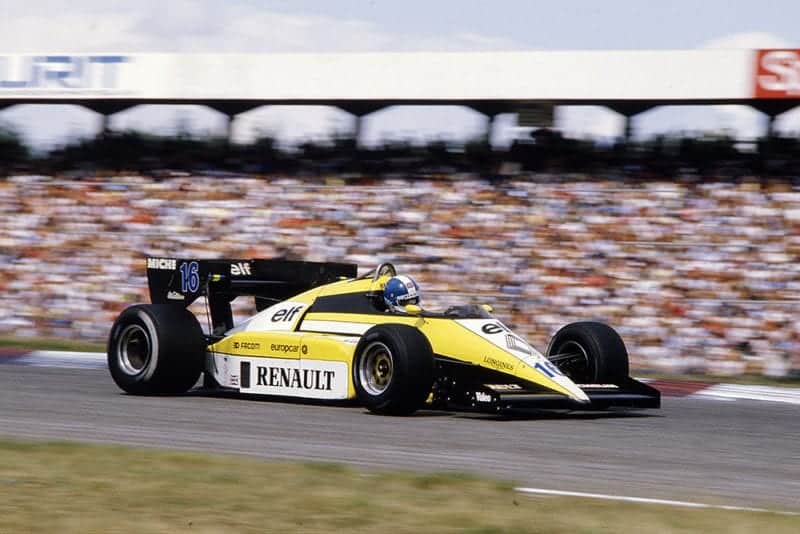
Warwick was 3rd fastest for Renault
Motorsport Images
As the hour progressed so did the heat, and inside the concrete bowl it was oppressive as everyone waited for the last few minutes before having a final go for pole position. Unfortunately Tambay had his Renault engine blow up and there was a lot of oil around the track in the stadium, which put paid to any more really fast times, so de Angelis actually retained pole position. Tambay had to make his qualifying time in Warwick’s car, as it was the T-car which had blown up. Tambay’s race-car had given trouble early on. There had only been 27 cars taking part, as the Toleman team had withdrawn their second entry, Cecotto being out of action following his Brands Hatch accident.
On Saturday morning the rain was pouring down and those who ventured out did so on heavily treaded wet-weather tyres, but there was little to learn. The main concern was that the weather would not clear up, so that Friday’s times would give the starting grid positions. While this meant joy in the Lotus team, it was despair in the Williams team, with Rosberg in last place. However, the weather men had promised that clear and dry weather was on its way so everyone splashed around hopefully. Sure enough, as the test session ended at 11.30 am, the sun appeared and vapour rose from the track as the hot sun dried things out.
As the track was not completely dried out by 1 pm, those who already had a good grid time from Friday were prepared to sit and wait, but Rosberg could not afford this luxury so was all wound up tight to go at the instant the pit lane was opened. Unfortunately he was held up by a recalcitrant body fastener that would not click shut and the Williams mechanics wasted a lot of time frigging about with it before sending him off with a piece of sticky tape holding it in place! Instantly Rosberg moved himself up from 27th place to 19th place. The others waited, Piquet sitting in the “lightweight” Brabham, immobile but ready to go, Tambay sitting in his Renault, Arnoux and Alboreto in their old type suspension Ferraris and so on. There was quite an air of tension in the pits, which the spectators could unfortunately not see or appreciate, being a million miles away in their vast grandstands. At 1.20 pm Tambay drove off down the pit lane, the first to break the tension and all eyes and stopwatches were on him, for his lap times were going to give an indication of the track conditions.

10th on the grid was all Ferrari’s Rene Arnoux could manage
Motorsport Images
Laffite went out, but caused little interest, though when Alboreto moved off down the pit lane interest perked up. As the fast boys began to make their first runs the tension subsided and by 1.40 pm all hell had broken loose. De Angelis was quick, but Prost was quicker, Warwick was still up with them, Piquet was not far behind and Lauda spun off onto the grass in the stadium! Things were hotting up. The Austrian was using a long-service engine in his McLaren and it was beginning to smoke and show signs of wear. Trying a bit too hard, too soon, Lauda lost it and spun. He returned to the pits with a damaged nose cowling and grass on the tyres, but nothing serious was wrong.
In the last ten minutes the pace was frantic but nobody could dislodge Prost from his pole position, though de Angelis was very close to him, these two being on their own in the 1 min 47 sec bracket, whereas Warwick, Tambay, Piquet and Alboreto were in the 1 min 48 sec bracket. In the 1 min 49 sec area were Lauda, Fabi, Senna and Amoux. Of these Fabi was particularly pleased, as he felt he was beginning to make Formula One progress at last, and Senna was there by reason of his Friday time, a continual misfire in the Hart engine preventing him going any quicker.
Race
It was raining again on Sunday morning, but not for long, and by the time the “warm-up” period started all was well, though the skies were not clear of ominous clouds. The Ferrari drivers were still in their T-cars, with the old suspension, and the other two cars had been converted back to the old layout, making Forghieri wonder why he bothered to design new things.
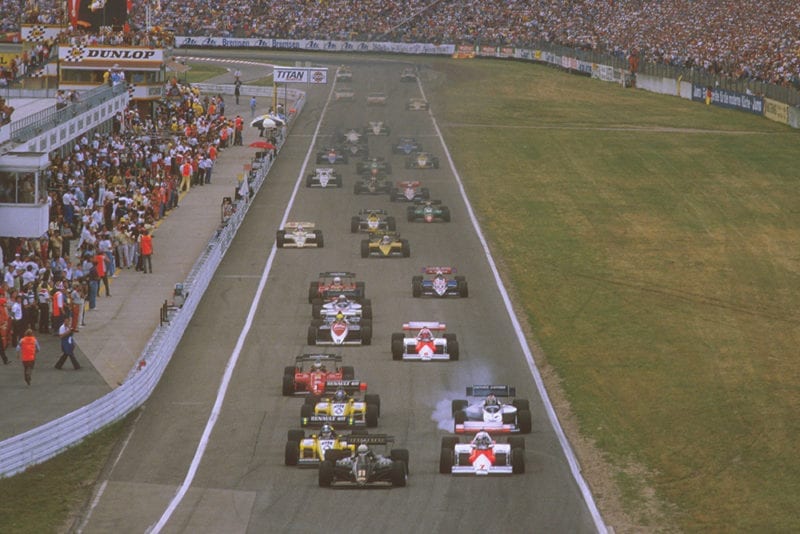
Lotus’ Elio de Angelis leads at the start
Motorsport Images
There were troubles at both ends of the pit lane during this half-hour, for Lauda arrived with his Porsche engine screaming its head off, the throttles halving stuck open and the ignition switch having failed, while down in the Spirit pit there was gloom as Rothengatter had stopped out on the circuit with a hole in the bottom of his Hart engine, so the spare car had to be made ready. Prost was soon back into his pit, his engine not running right in the McLaren, but the Brabham team and the Lotus team seemed to be in good order. The race was not due to start until 2.30 pm so there was enough time to sort things out, for Formula One standards of work can accomplish miracles while most people are having lunch.
Although it was warm and dry as the cars were prepared for the race there were still some heavy clouds circulating, and as they formed up on the grid a few spots of rain fell, but did not develop into anything. Prost had rushed back into the pits, his engine still not running properly and as the fuel pump was suspect he was strapped into the waiting T-car and tore off round the circuit once more to take up pole position long after everyone else was in position. All was in good order and Prost led the field away on the parade lap, seeming to be gone for an awful long time as the Hockenheim circuit is one of the longer ones. They all arrived back safely and as the tail-enders stopped on their marks, the lights came on red, then blinked to green and all 26 cars surged away. From his inside position de Angelis made a beautiful getaway and got the drop on Prost, while Warwick sliced across and tucked in behind the Lotus. They sorted themselves out on the opening lap and de Angelis led back into the stadium, followed by Prost, Piquet, Warwick, Tambay, Senna, Alboreto, Lauda. Fabi and the rest. Rosberg was picking off the tailenders very quickly and his pace was such that one could be forgiven for thinking that he was on half a tank of petrol and soft tyres in a bid to make some sort of showing. When 25 cars had gone by and out of the stadium, the 26th arrived, this being the Arrows-BMW of Surer which had gone wrong in its fuel injection system and would only run on tick-over. He trickled into the pits but nothing could be done about it.
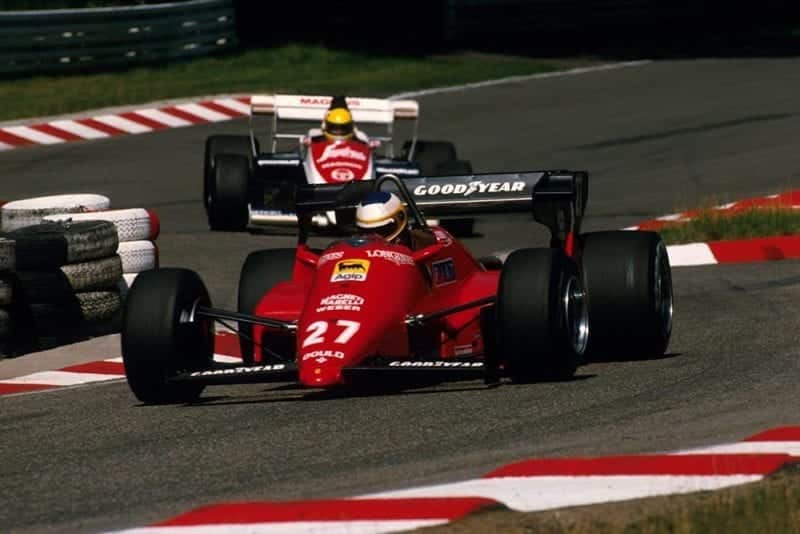
Michele Alboreto keeps his Ferrari ahead of Ayrton Senna
Motorsport Images
Within three laps a gap had appeared after Piquet and before Warwick arrived, and while de Angelis looked comfortable in the lead, he could not have felt comfortable with Prost and Piquet lurking behind him. Senna was an impressive fifth in the Toleman ahead of Tambay, but on lap five he had the father-and-mother of spins on the fast outward leg before the East Curve chicane, and thumped the Armco with the right rear corner. The rear aerofoil had broken away and collapsed while he was doing about 175 mph on the long right-hand curve. He escaped without so much as a bruise and was remarkably cool and collected about the whole thing afterwards, not so much annoyed by the breakage, but the fact that the car was going so well and he had his sights on Warwick’s Renault at the time. The incredible Rosberg was now up to seventh place.
The scene at the front did not last long, a mere seven laps out of the scheduled 44, for on lap 8 the Renault engine in the Lotus blew up and as Prost dodged past into the lead, Piquet went one better and went by both the stricken Lotus and the McLaren, to lead back into the stadium at the end of lap 8. Now it was a straight confrontation, Piquet versus Prost, BMW engine versus Porsche engine, and both cars were on Michelin tyres so there were no excuses. It looked like stalemate for neither driver seemed to have any sort of advantage and Lauda was too far behind in third place to join in with any team tactics. The Austrian had started off carefully, as is his normal practice, and had passed Rosberg and Warwick as the race settled down. Within a lap the two Williams-Hondas failed, to complete a really miserable weekend for the Didcot team. Laffite came into the pits with smoke pouring from an exhaust pipe and signs of a disintegrated piston coming out of the pipe, and Rosberg coasted to a stop out on the circuit with an electrical fault.

De Angelis’ race lasted only 8 laps after his Lotus developed a turbo problem
Motorsport Images
Barely had the Williams cars gone than the second RAM car disappeared and then Gartner drove into the pit-lane with his Osella carrying a merry little bonfire around its righthand turbocharger on the V8 Alfa Romeo engine. Alboreto went out with an electrical fault and Patrese broke his gearbox. The high-speed circuit with its three chicanes calling for instant stop-and-go tactics was taking its toll. On lap 22 Piquet found difficulty in selecting gears and slowed dramatically, with Prost and Lauda both going by. The Brabham was using its special 6-speed gear cluster, to give five normal ratios and a sort of over-drive top, and Piquet was having trouble finding second, fourth or sixth. He did one more lap trying to sort things out but to no avail, and drove into the pits at the end of lap 23. Mischievous as ever, the little Brazilian indicated to his mechanics that he wanted all four tyres changed as he pulled up. This they did in typical Brabham efficient manner and when they all stepped back after little more than 10 seconds, Piquet undid his seat belts, stood up and took his helmet off, roaring with laughter. Such is the respect for the World Champion within the Brabham team that the joke was taken in good part by everyone.
Meanwhile, out on the rather dull track the two McLarens were in total command, the red and white cars looking a picture of efficiency as they droned their way onwards. No matter what you care to call the Porsche engine, or who is paying for it, as far as the Hockenheimring was concerned, Stuttgart had won the day over Munich, even though this time the fault did not lie with the M-Power engine. It had been an interesting German industry confrontation while it lasted. We were only just at the halfway point but it was all over. Lauda had a bit of a go to see how fast Prost was going, but the Frenchman responded instantly so the wily Austrian eased off and settled for second place, and the McLaren, Marlboro, TAG, Porsche combine kept a watch on two cars as they circulated together with no opposition in sight.
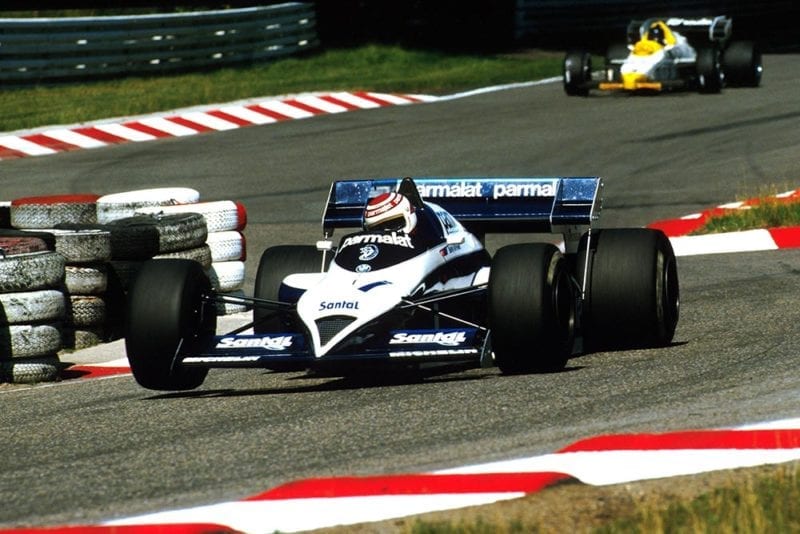
Nelson Piquet retired on lap 23 with gearbox failure
Motorsport Images
In a lonely third place, but quite content with things, came Derek Warwick, followed by Fabi in the second Brabham, but on lap 28 the boost pressure on the Brabham began to sag and the second blue and white car from Chessington was out. It really was a Stuttgart white-wash. A long way back (by today’s standards that is) came Patrick Tambay struggling hard with an engine that did not seem to have enough power, and he was being hauled in by Nigel Mansell who had worked his way up from 16th place on the grid, eventually to pass the Renault and take a worthwhile fourth place. At the back of the field there was a jolly little dice going on between the two Ligier-Renault drivers, Francois Hesnault not only keeping station with his team-leader Andrea de Cesaris, but actually leading him a lot of the time. The two of them passed and repassed continually, which helped to keep the huge crowd awake, for if you weren’t a Porsche fan the whole thing had become very boring. Arnoux’s Ferrari was still running but he was lapped by the McLarens and right at the back of what was left, Rothengatter’s gearbox was breaking up under his strong right arm, while Johansson was keeping his Tyrrell going as well as he could on this fast circuit.
It all ran out according to plan, the McLarens finishing a magnificent first and second, with fastest lap to Prost as a bonus. The Ligier team race fizzled out on the last lap as Hesnault’s car ran out of fuel, though he was able to coast over the line, thankful that he had been lapped by the leaders, so that he only had to cover 43 laps.
Immediately after the finish the first six cars were weighed and Prost’s McLaren showed 551 kg, Lauda’s McLaren 546 kg and Warwick’s Renault 550 kg, just as they finished. Think on that. Around 1,200 lb or 10 1/2 cwt in racing trim, with at least 650 bhp available at around 11,000 rpm. The modem Formula One car may not look exciting to some people, but just try to imagine the performance! — D.S.J.
